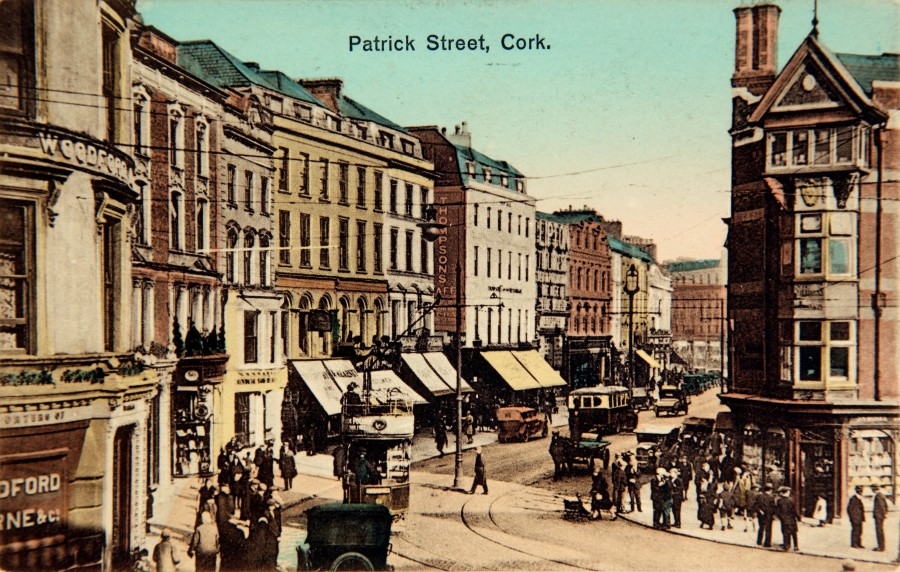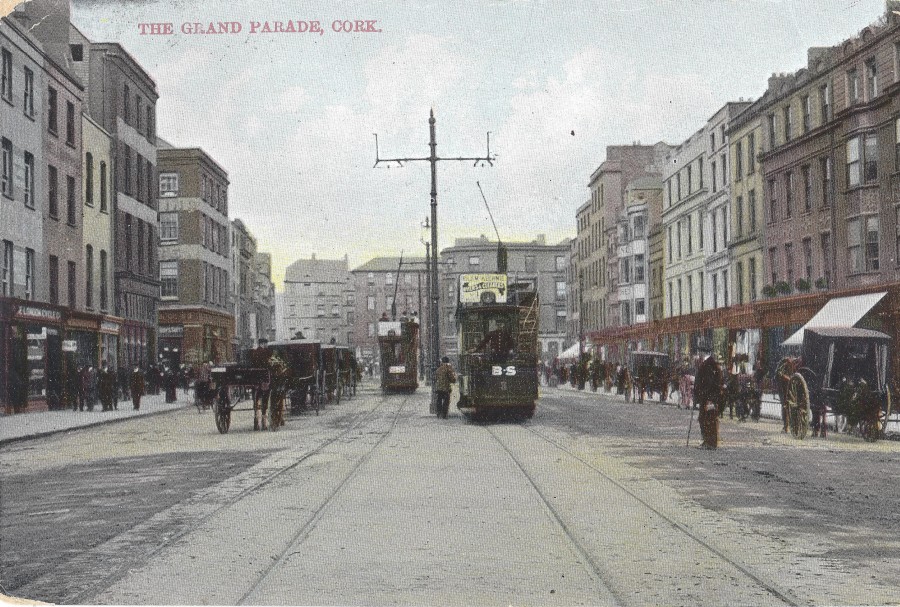Losing the Past, Losing Ourselves
Published in Irish Examiner, 6 July 2017
Like everyone else on Cork’s Lee Fields, I watched with great sadness the burning of the old St Kevin’s Asylum (built c.1895-1899) and had that deep sense of shock and loss – not just at one level but across a number of levels – Yes – St Kevin’s Asylum had a harrowing past but it’s future should not have played out this way.
Chatting to Corkonians they expressed their sadness and frustration that a part of Cork’s social history was burning and being destroyed; they were sad to see a burnt scar of a landmark emerging on the cityscape in one of the city’s scenic spots – dismayed that it was a potential arson attack out resulting out of someone’s boredom, frustrated that campaigns over the years by resident community groups and public representatives did not gauge muster with the owners of the site, sad that the owners of the site, the HSE, did not get to pursuing a plan for the site (despite having completed some really tasteful renewal works in the old Cork workhouse at St Finbarr’s Hospital), upset for the memory and almost forgotten memory of former patients and former staff members, frustrated that in the national context, there are many other old asylum buildings that are decaying and not being utilised for a myriad of potential uses.
Huge depths of multiple feelings unveiled themselves along the banks of the Lee last evening – feelings that were all about responsibility around harnessing and how to capture for the present and future a city’s (and a nation’s) history and heritage.
The fishermen, who called in the fire sat on the river railing, lamented to the press on the emerging scarred landscape. The River Lee at this point is bound up with a necklace of beautiful nineteenth century buildings across it northern ridges– some with harrowing histories like Our Lady’s Hospital and the Good Shepherd Convent with its Magdalene Asylum – some with stories of innovative local government like the Old Waterworks, some with gorgeous artwork like the stained-glass windows in St Vincent’s Church. The former Our Lady’s Hospital is now in the last phase of redevelopment by a private developer as tastefully done apartment blocks – the old Waterworks is now a notable tourism attraction run by Cork City Council on Ireland’s Ancient East with themes around renewable energy, waste, education and science. Investment into these sites have worked and a return for the investment is being reaped as well as emanating sustainable best practice in what to do with old building stock. These are best practice examples.
The now burnt out old St Kevin’s Asylum and the ruined and formerly burnt out Good Shepherd Convent remain ‘worst case’ examples of what happens if one does not invest. The hands of local government councils need to be strengthened – that finance and staff are made available to compulsorily purchase property, which is not being developed. Cities, town and regions should not have to endure sadness, loss, frustration and dereliction. It is not positive to have buildings, small to large, boarded up for years, to leave them decay, and to not have a plan. Going forward we need to reverse our approaches to dereliction – ideas, future planning and investment are needed to breathe life into our historic cities like Cork – in fact anytime we have, the ideas of the past have worked and have always helped frame the visions of the future.
Dr Kieran McCarthy, Independent Councillor, Cork City Council, www.corkheritage.ie

Kieran’s Our City, Our Town Article,
Cork Independent, 6 July 2017
The Wheels of 1917: Amnesty Disturbances
The evening of Sunday 24 June 1917 was one of violence on Cork streets. It followed the arrival home of the eight Irish Volunteers in Cork City (see last week’s article) on the previous day and a procession and speech-giving at the National Monument. Members of Sinn Féin continued their campaign of action over the ensuing 24 hours. The Cork Examiner records that the demonstrations began as a crowd of Sinn Féin supporters returned from a camogie match between Plunketts and Clan Emer, at O’Neill Crowley Grounds, Western Road. They were escorted by the Piper’s Band. When the Gaol Cross was reached an attack was made on the gaol, stones being thrown and some windows broken. Cheers were also raised for the Cork volunteers who were prisoners there, and these were answered with cheers from within the gaol walls.
This crowd then proceeded to Sheare Street and retook possession of the Irish Volunteer Hall, which the military had taken over. From mid afternoon until after 11pm riots were pursued. It started with an organised attack by youths on the Recruiting Office on St Patrick’s Street, the plate glass windows of which were smashed on the previous Saturday night. The smashed area was boarded up but the youths broke down this structure with sticks, removed recruiting posters from the window and tore down the flags, which hung over the facia board. A young man climbed the tramway pole opposite the offices and cut down the Union Jack, which had flown there since the beginning of the war. This was thrown into the river.
The crowd now numbered several hundreds, and young women whose relatives were in the war, incensed Sinn Féin supporters by attacking them. Under District Inspectors Walsh and Swanzy, the police – armed with carbine rifles, bayonets, revolvers and batons – were on the streets in full force. The police charged the crowd on St Patrick’s Street. Carbine rifles were lowered and bayonets fixed, and revolver shots cracked out now and again. The corner of King Street (now MacCurtain Street) and Bridge Street was the stand-off of the rival parties of both sides. The police on St Patrick’s Bridge prevented persons coming into St Patrick’s Street where Sinn Féin members were in strength. Canon O’Leary, Rev Father McSweeney, and other clergy of SS Peter and Paul’s Church, as well as 1916 veteran J J Walsh, arrived onto the streets during the disturbances counselling the people to go home, but their advice was ignored.
The answer by the police was to re-charge and re-charge. Several persons were wounded in the bayonet thrusts, by being struck with the butt end of the rifles. One man received shot wounds. Many fell and suffered bruises by being trampled on. All the wounded were all taken to the North Infirmary for treatment. One of the men, Abraham Allen aged 25 years, living at the North Mall, was shot in his thigh.
Shortly before midnight it seemed as if the centre of the city was about to return to normal and it was decided that a number of the police return to the Bridewell and Tuckey Street Barracks. About twenty police were marched to Woodford Bourne’s corner on Daunt’s Square, where they were ordered to halt, preparatory to proceeding to their respective barracks. There were very few civilians in this particular portion of the street at the time, but without warning a fusillade of stones, came from a dark corner at the square. A number of the police were struck, while many stones reached window on the Grand Parade tide at the street. A bayonet charge followed. The stone-throwers, who were few in number, ran through Castle Street, pursued by some of the police, and a number of women who had congregated at the entrance to Cornmarket Street. At the upper end of Castle Street, the stone-throwers entered North Main Street, and escaped their pursuers.
Portions of the crowd that had been driven from the flat of the city by baton and bayonet charges earlier in the evening began to return towards St Patrick’s Street, and another collision followed with the police. Many injuries were sustained. The crowd was soon dispersed. About 12.15am Sergeant Grey was brought to the Bridewell suffering from wounds under his left eye. It was caused by a revolver bullet, received in the course of action. Through the counter attacks on the baton and bayonet charges in St Patrick’s Street, several other policemen also sustained wounds.
About 11.15pm the military arrived on the scene, and took up positions between Fr Mathew Statue and Cash’s Drapery Store at the Winthrop Street intersection. This detachment was fully armed and cut off communication to the centre of the city. Their preparations for eventualities were elaborate. They had machine guns, which they placed in position to command St Patrick’s Street. They were accompanied by a chaplain, and brought with them a motor ambulance and stretcher bearers. The police in batches patrolled the various streets and cleared the crowds from the centre of the city, subsequently cutting off communication to it. It was nearly midnight when the violence quietened down and the military were withdrawn at 1.45am.
Secret Cork (2017) by Kieran McCarthy is now available in Cork bookshops or online at Amberley-books.com
Captions:
902a. View from Daunt Square side of St Patrick’s Street, c.1930 (source: Cork City Through Time by Kieran McCarthy & Dan Breen)
902b. View of Grand Parade c.1910 (source: Cork City Through Time by Kieran McCarthy & Dan Breen)


